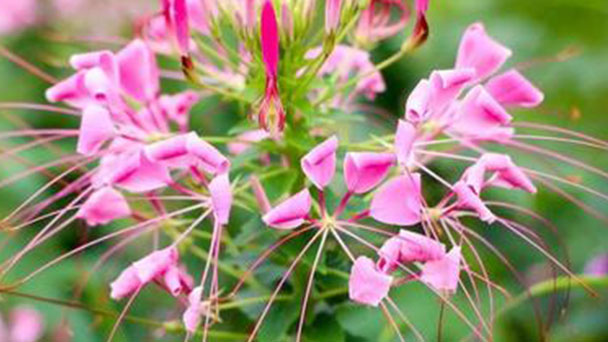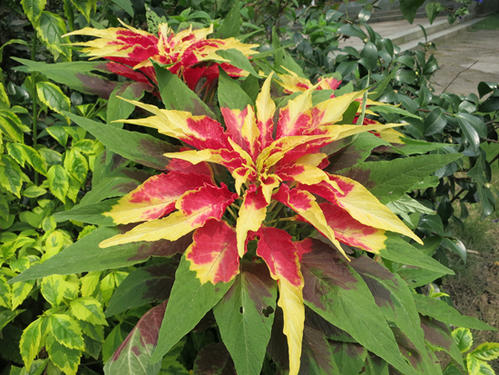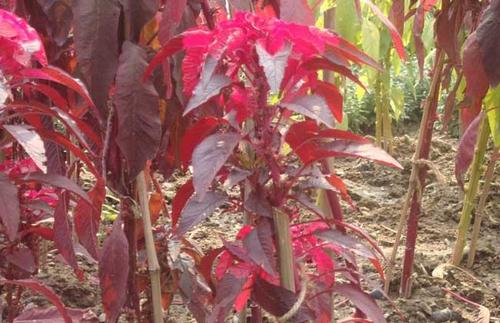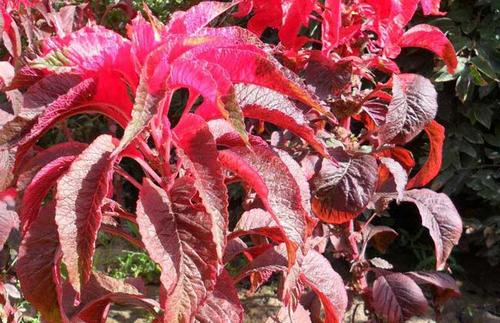Josephs coat (Amaranthus tricolor) profile
Written by Maggie
Nov 05 2021

Joseph's coat (Amaranthus tricolor) is an annual herb, stems erect, 14-45 cm tall, simple or branched, covered with glandular hairs. Lower leaves are opposite, upper leaves alternate, broadly ovate, oblong, and lanceolate, 2-7.5 cm long, apically acute, base tapered or semicircular, entire, pubescent;Origin in tropical Asia.
Joseph's coat is an annual herb in the family Amaranthus. The plant is 80 -- 100 cm tall. The stem is erect and less branched. Leaves are alternate, rhombicular ovate to lanceolate. The flowers are very small, spikes are born between leaf axils, and the seeds are black and shiny. Joseph's coat originates in Mexico. In China, gardens are cultivated throughout the country.
Joseph's coat picture

The morphological characteristics of Joseph's coat
Joseph's coat is an annual herb, stems erect, 15-45 cm tall, simple or branched, covered with glandular hairs. Lower leaves are opposite, upper leaves alternate, broadly ovate, oblong, and lanceolate, 2-7.5 cm long, apically acute, base tapered or semicircular, entire, pubescent;Without a petiole. Inflorescence of Joseph's coat is terminal paniculate, pubescent, pedicels very short; Calyx is cylindric, calyx lobes lanceolate subulate, 2 -- 3 mm long, pubescent outside, spreading or curved when fruitally; Corolla is saucer-shaped, 1 -- 2 cm in diameter, pale red, dark red, purple, white, pale yellow, lobes rounded, slightly shorter than corolla tubes; The stamens and styles of Joseph's coat are much shorter than the corolla. Capsule elliptic, ca. 5 mm, with persistent calyx below. Seeds are oblong, ca. 2 mm long, brown.
Joseph's coat is an annual plant, 60-100cm tall, stalks erect, stout, green or red, few branches, single leaves alternate, ovate or rhombic ovate, long stalk. In early autumn, the upper leaves change color, while the common varieties turn red, yellow and green, while the superior varieties are bright yellow or bright red and gorgeous. The top leaves are especially bright red and dazzling. Flowers of Joseph's coat are small, unisexual or heteroecious, fascicled axillary or terminal spikes, inflorescences small and inconspicuous, unisexual or bisexual, monoecious. Berry is ovate, mature in autumn; Seeds are small and bright black.
The ecological habits of Joseph's coat
Joseph's Coat is drought-resistant, not cold-resistant, and prefers humid, sunny and well-ventilated environments., like fertile and well drained soil. Joseph's coat likes a humid sunny and well-ventilated environment, avoids water logging and heat and humidity. The soil requirements are not strict, suitable in the fertile soil with good drainage, there is a certain alkaline resistance, can sow and multiply.
How to grow and care for Joseph's coat
1. Soil care
Joseph's Coat is not strict with the soil. Potted Joseph's Coat is generally a mixture of garden soil, leaf rot soil and fine sand. It is loose, fertile and has good drainage, and has a certain resistance to alkali.
2. Light and suitable temperature
Joseph's Coat loves the sun and needs sufficient light to grow vigorously during its growth period, which is controlled for a certain period of time to facilitate the formation of flower buds. In terms of temperature, the growth temperature should be between 18℃ and 25℃ to ensure a warm growth environment. Joseph's Coat is not hardy and needs to keep its overwintering temperature above 10 ° C in winter.
3. Watering and nutrient care
Joseph's Coat requires an adequate water supply during growth, and be sure to control watering. Keeping the soil moist will allow Joseph's Coat to grow well. Overgrowth may occur, but don't be short of water.
Although Joseph's Coat can withstand drought, it should not be too dry, which can cause yellowing or even peeling of Joseph's Coat leaves. You don't need to apply too much fertilizer. Joseph's Coat usually applies a sufficient base fertilizer during planting and can apply it 2-3 times during the growing season to meet the needs of various growth elements.
4. Pruning
While Joseph's coat is growing, it can be cored, which makes Joseph's coat more branching. You can also pluck the heart and let it grow. Potted Joseph's Coat plants can be quite large without being peeled, so measures should be taken to prevent lodgings. (Find more fall plants here.)
The way Joseph's coat propagates
Sow propagation, cuttage propagation can also be.
1. Sowing propagation of Joseph's coat will be carried out in spring. Direct seeding on open seedbed is usually used. Shade the light when sowing. Because its seeds fall naturally after maturity, it must be picked in time. After sowing, pay attention to management, keep the soil moist and the temperature at 15 ~ 20°C, and the seedlings can emerge in about 7 days. In low tropical latitudes, it often sows in winter, emerges in spring of the following year, and leaves can change color, and the ornamental period is relatively long.
Joseph's Coat can also delay sowing, i.e., planting in summer. But the late sowing plant, obviously short, the end of September leaves become red, can be used for National Day decoration.
2. Cuttage propagation The Joseph's coat of cuttage propagation is small, so it is rarely used, but in order to maintain the excellent characteristics of the mother plant is often used; Or because sow seedling little cannot satisfy a need, passed sow season again, also can undertake propagate through cuttage. Cuttage in its growth season, cut the upper branches as cuttings, cut into 10 ~ 15cm long, cut to flat, the lower cut from the base of about 2mm, inserted into fine sand, vermiculate, perlite can be. If the cuttings are soaked with 0.1% ABD rooting agent for 1 to 2h, they can take root 2 to 3 days in advance.

The distribution of Joseph's coat
Joseph's Coat is originally from tropical Asia and is widely cultivated in China. Joseph's coat is distributed in mainland China, India, Japan, Central Asia and other places.
Disease control of Joseph's coat
Joseph's Coat is often damaged by diseases and insect pests during cultivation, which leads to fertility obstruction and greatly reduces the ornamental value of Joseph's Coat. In several years of cultivation and management, white whitefly, root rot and stem rot are found to be the most likely pests to occur. Here is a brief introduction to the prevention and control methods of these diseases and pests:
(1) Whitefly is the most common pest in Joseph's Coat cultivation and can occur all year round in the greenhouse. When whitefly do their damage, leaves can develop white patches or turn green
Prevention and control measures:
(1) Do a good job of surrounding environmental health: remove weeds, withered branches and leaves around, block the source of insects;
(2) The activity of white whitefly can be judged and monitored by hanging the yellow sticky insect board in the greenhouse;
(3) Pesticide control: the main application of insecticides are Wan Ling, Pu Lili Ling, quick killing, etc.
(2) Root rot and stem rot. This disease is most likely to occur in the seedling stage at low temperature and high humidity.Symptoms are roots and stems appear brown rot, root skin will sometimes fall off, the lower leaves of the plant will turn yellow, leaves, in severe cases the whole plant will appear cataplexy, death.
Prevention and control methods:
(1) Remove infected plants;
(2) conduct matrix disinfection;
(3) use fungicides to irrigate or spray during colonization, the main agents are oxamylin, rhizobacterialil and so on.
Treat dysentery, vomiting blood, blood collapse, eye blindness.
Joseph's coat landscaping purposes
Joseph's Coat is an excellent foliage plant. It can be used as a backdrop for a flowerbed, in a hedge, on the side of the road, or planted in a large area on a lawn to create a colorful pattern with flowers and plants.

Read Next:
Top 30 Fall Flowers to Plant - Beautiful Autumn Flowers
30 Fall Plants for a Beautiful Fall Garden
Latest Updated
- Benefits of Bugleweed - 7 Science-backed Health Benefits
- Bugleweed Dangers & Side Effects - Is It Poisonous?
- How to Plant Evergreen Trees - What You Should Know
- When to Plant Evergreens - Grow Guide for Evergreen Trees
- 12 Wonderful Evergreen Shrubs for Your Garden
- 12 Popular Evergreen Plants with Pictures for Beginners
- When And How To Prune A Lilac Bush Like a Pro
- How to Grow & Care for Lilac Vine (Hardenbergia Violacea)
- Japanese Lilac Tree (Syringa Reticulata) Care & Propagation Guide
- Shumard Oak Pros and Cons - What to Know
Popular Articles
- Winter maintenance of Antirrhinum Majus
- How to Grow Terminalia Mantaly Tree
- How to Grow and Care for Crossostephium Chinense
- How to grow Antirrhinum Majus in spring
- Peristeria Elata (Dove Orchid) Profile: Info & Care Guide
- Underwatered Snake Plant (Sansevieria Trifasciata) - Signs And How To Fix
- How to Care for Brazilian Jasmine Plant (Mandevilla Sanderi)
- How to Grow & Care for Graptopetalum Purple Delight in Summer
- Rosa Chinensis (China Rose): Plant Growing & Care Tips
- How to Care for Baby Sun Rose (Aptenia Cordifolia)